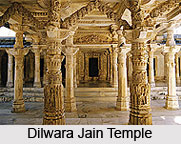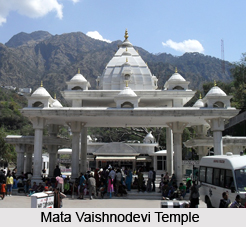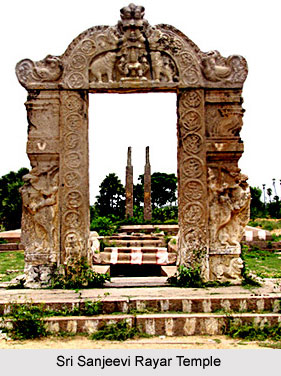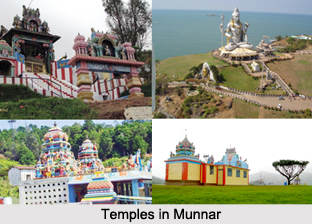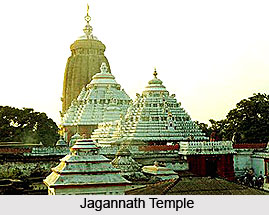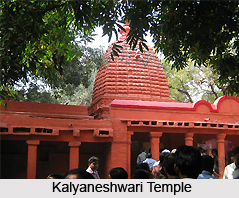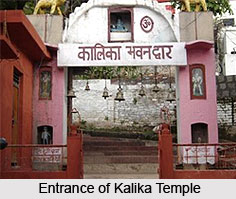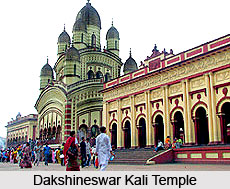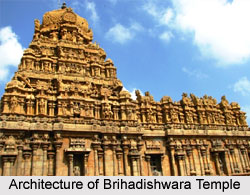Introduction
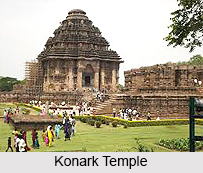 Konark Sun Temple in Odisha was built in 13th Century that is the early phase of medieval era. The magnificent Sun Temple of Konark is the culmination of Odisha"s temple culture, which is well, described by Rabindranath Tagore "where the language of stone surpasses the language of man".
Konark Sun Temple in Odisha was built in 13th Century that is the early phase of medieval era. The magnificent Sun Temple of Konark is the culmination of Odisha"s temple culture, which is well, described by Rabindranath Tagore "where the language of stone surpasses the language of man".
Derivation of the name Konark
Konark is also known as Konaditya. The name Konark derived from the words Kona - Corner and Arka - Sun is situated on the north eastern corner of Puri or the Chakrakshetra. It is also known as Arkakshetra. The temple was built by King Narasimhadeva (1238-1264 AD) of Ganga Dynasty to celebrate his victory over the Muslims.
God in Konark Sun Temple
This masterpiece architecture is dedicated to the Sun God or Surya.
Location of Konark Sun Temple
The Sun Temple of Konark is situated in the eastern state of Odisha, located sixty-five kilometers away from Bhubaneswar and thirty-five kilometers away from Puri. It was one of the earliest centres for Sun worshipping.
Architecture of Konark Temple
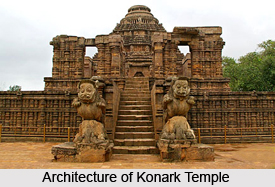 The magnificent ruins on the sandy sea-shore at Konark, at a distance of about twenty miles from Puri, represent the celebrated Konark Temple or Black Pagoda of Orissa, which used to receive the first rays of the sun, rising over the boundless expanse of the Bay of Bengal, to warn the mariners of the danger which the surf still offers to navigation along the coast.
The magnificent ruins on the sandy sea-shore at Konark, at a distance of about twenty miles from Puri, represent the celebrated Konark Temple or Black Pagoda of Orissa, which used to receive the first rays of the sun, rising over the boundless expanse of the Bay of Bengal, to warn the mariners of the danger which the surf still offers to navigation along the coast.
A temple in Orissa consists of (1) the deul or the holy of holies, (2) the Jagamohana or the porch, (3) the Natamandira or the dancing-hall and (4) the Bhogamandira or the hall of offerings. Of these four parts, the Natamandira does not appear to have ever been attached to the Black Pagoda. But presently what remains is a still porch.
The Konark Sun Temple was originally surrounded by a walled enclosure measuring 750 feet by 500 feet. The Jagamohana or the porch, which is still visible in a fair state of preservation, owing to the recent work of "restoration," will amply repay the trouble of visiting the place. It stands on a foundation 66 feet square, with a total height of 100 feet. It consists of vertical walls which, at a height of 60 feet, terminate in a pyramidal roof, with a slope of 72 feet. The friezes in the projecting cornice, arranged in three tiers, in the sloping roof alone, present about 3000 feet of carving, with an astonishing variety of sculpture, portraying almost every aspect of Indian life-pastoral, domestic, civil and military.
The temple was constructed in the form of a chariot. The chariot is drawn by 24 wheels and seven horses. Each wheel of the chariot is 10 feet in diameter. The spokes of the wheel represents the sundials. It is said that wheels represent 24 hours of the day and some says that the wheels represent the 12 month concepts of the year.
Two lions guard the entrance of the temple indulged in an act of striking the elephants. A flight of steps lead to the main entrance. The entire structure of the temple is filled with intricate carvings, sculpture and wonderful images.
The material which has been used for building the Konark Temple is mainly basalt. Immense sized blocks of stone and the huge beams of Iron have been used in the construction of the temple. The sculptures in high relief bear witness to an age when Hindu artists worked form nature. The nymphs are beautifully shaped women, in luscious attitudes; the elephants move along at the true elephant trot, and kneel down in stone as they did in life.
It can be concluded saying the fact that Indians had a keen eye for beauty and details for beauty and perfection. This is undoubtedly visible at Konark, where the effect of the Sun temple was due largely to the contrast between the boundless expanses.
Legend Of Konark Temple
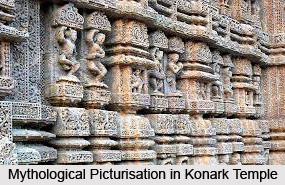 The legends of Konark temple in Orissa narrate the tales of Samba Purana, the son of Lord Krishna by one of his numerous wives named Jambavati. He was stricken with leprosy, as he had unwittingly incurred the displeasure of his irate father for having been found loitering listlessly about the bathing-place of his father`s wives. He was advised to repair to the Maitravana on the river Chandrabhaga to get rid of his sufferings by austere penance in the worship of the Sun. The Sun had been worshipped in India from the earliest antiquity not only as the great source of light but also as the great healer of incurable diseases. Numerous temples, dedicated to the Sun, existed all over India, and the Maitravana appears from this Puranic account to have acquired a special celebrity. Pilgrims still resort to it once a year in the month of Magh.
The legends of Konark temple in Orissa narrate the tales of Samba Purana, the son of Lord Krishna by one of his numerous wives named Jambavati. He was stricken with leprosy, as he had unwittingly incurred the displeasure of his irate father for having been found loitering listlessly about the bathing-place of his father`s wives. He was advised to repair to the Maitravana on the river Chandrabhaga to get rid of his sufferings by austere penance in the worship of the Sun. The Sun had been worshipped in India from the earliest antiquity not only as the great source of light but also as the great healer of incurable diseases. Numerous temples, dedicated to the Sun, existed all over India, and the Maitravana appears from this Puranic account to have acquired a special celebrity. Pilgrims still resort to it once a year in the month of Magh.
The worship of a sacred tree came also to be associated with this place, and we have a reference to it in the Kapila samhita. Konark appears, therefore, to have given shelter to Buddhism, when that faith prevailed in all parts of Orissa. The Black Pagoda or Konark temple might, thus, have been built with older materials during the restoration of Sun worship after it had been temporarily superseded by Buddhism. The twenty-eight temples, said to have performed miracles, are no longer in existence. It would be interesting to know what faith used to be represented by them.
Some of the local legends say that King Narasimha Deva-I of the Ganga Dynasty had initiated the construction of the Black Pagoda. It is said that he wanted to build the temple as an epitome of his political supremacy. The legend also has that around 1200 architects and artisans had worked for a period of continuous 12 long years to build the temple.
Today it is generally described by the priests as one of the four Kshetras or holy places of Orissa, where Lord Vishnu left his weapons in his conflict with the great demon Gaya. According to this legend, Puri is the Sankha Kshetra where the conch shell was left; Jajpur District is the Gada Kshetra, where the club was left; Bhuvaneshwar is the Chakra Kshetra, where the discus was left; and Konark is the Padma Kshetra, where the lotus was left. But Konark had yet another name, which is scarcely remembered now. It was called the Maitra vana.
Sculpture of Konark Temple
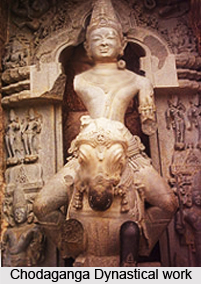 Konark Temple has been known for the supreme achievement of the architectural genius of Odisha. Situated about 20 miles northeast of Puri in Odisha, this temple is a result of the continuous development for centuries. The temple was built, during the reign of the eastern Ganga King Narasimha Deva I (1238-1264). The name of the place `Konark` is derived from Konarka, the presiding deity of the Sun Temple. The temple is dedicated to the Sun God and its entire appearance is conceived of as a rath, giving the name `Temple on Wheels`. The entire temple is designed to achieve the shape of a colossal chariot with seven horses and twenty-four wheels, for the Sun God, carrying him across the heavens.
Konark Temple has been known for the supreme achievement of the architectural genius of Odisha. Situated about 20 miles northeast of Puri in Odisha, this temple is a result of the continuous development for centuries. The temple was built, during the reign of the eastern Ganga King Narasimha Deva I (1238-1264). The name of the place `Konark` is derived from Konarka, the presiding deity of the Sun Temple. The temple is dedicated to the Sun God and its entire appearance is conceived of as a rath, giving the name `Temple on Wheels`. The entire temple is designed to achieve the shape of a colossal chariot with seven horses and twenty-four wheels, for the Sun God, carrying him across the heavens.
History of Konark Temple
The current temple is attributed to Narasimhadeva I of the Eastern Ganga Dynasty, 1238–1264 CE. It is one of the few Hindu temples whose planning and construction records written in Sanskrit in the Odiya script have been preserved in the form of palm leaf manuscripts that were discovered in a village in the 1960s and subsequently translated. The temple was sponsored by the king, and its construction was overseen by Siva Samantaraya Mahapatra. It was built near an old Surya temple. The sculpture in the older temple`s sanctum was re-consecrated and incorporated into the newer larger temple. This chronology of temple site`s evolution is supported by many copper plate inscriptions of the era in which the Konark temple is referred to as the "great cottage".
The temple was built in the 13th century. It consisted of two main structures, the dance mandapa and the great temple (deul). The smaller mandapa is the structure that survives. The great deul collapsed sometime in the late 16th century or after.
Architecture of Konark Temple
The base of the temple is formed with an immense terrace with twenty-four giant wheels; each one is around 10 feet high, on either side. Therefore, the temple is constructed on the raised platform and the actual temple building is erected in two conjoined parts. The natmandir and the bhogmandir are constructed as separate structures, but enclosed within a courtyard measuring 865 ft. by 540 ft. The masterpieces of Hindu art show the presence of Hindu God and Goddess in its expressions. The carving with minute details and attributions of them can be said as the characteristic of the art.
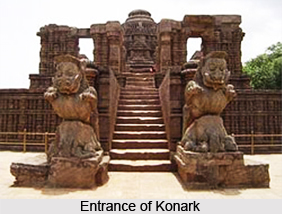 The temple is known for its impressive Kalinga architecture that includes a depiction of a 100 ft high chariot being pulled by horses and wheels carved out of a single stone. The monument portrays the imposing chariot of the Sun God. Built of Khondalite rocks, the original temple had 230 ft high sanctum which no longer exists, 128 ft high audience hall, dance hall, dining hall which still survive. There are 24 intricately designed wheels, 12 ft in diameter which are seen drawn by horses. These seven horses represent the week, the wheels stand for the 12 months while the day-cycle is symbolized by the eight spokes in the wheels. And this whole depiction tells how the time is controlled by the Sun – being the very illustration of the Surya in the Hindu mythology travelling from the east in his chariot escorted by his charioteer, Aruna.
The temple is known for its impressive Kalinga architecture that includes a depiction of a 100 ft high chariot being pulled by horses and wheels carved out of a single stone. The monument portrays the imposing chariot of the Sun God. Built of Khondalite rocks, the original temple had 230 ft high sanctum which no longer exists, 128 ft high audience hall, dance hall, dining hall which still survive. There are 24 intricately designed wheels, 12 ft in diameter which are seen drawn by horses. These seven horses represent the week, the wheels stand for the 12 months while the day-cycle is symbolized by the eight spokes in the wheels. And this whole depiction tells how the time is controlled by the Sun – being the very illustration of the Surya in the Hindu mythology travelling from the east in his chariot escorted by his charioteer, Aruna.
The entrance leads to the shrine of the deity of Surya made of chlorite stone. The walls of the temple are adorned with reliefs – intricate carvings of various figures including Hindu gods, images of the everyday mortal life, birds, animals and more. The temple also has erotic sculptures on its shikhara belonging to the tantra tradition. The wheels of the temple can be used as sundials and can well predict the time.
Sculptures in Konark Sun Temple
The excellent appearance and vitality of the structure is due to the roof in pyramidal style with its three tiers and sculptured figures. The sculpture that embellishes the outer surfaces of this architectural masterpiece is equally exquisite in its luxuriance and also employs many techniques of invention than the vast structure itself. The exterior part of the temple structure is chiseled and molded with either using abstract designs, or fantastic human and animal forms. The sculptors have tried their best to use every motif and subject known to the Indian mind in the theme of carvings.
The walls of the temple from the base through the crowning elements are ornamented with reliefs, many finished to jewelry-quality miniature details. The terraces contain stone statues of male and female musicians holding various musical instruments including the veena, mardala, gini, etc. Other major works of art include sculptures of Hindu deities, apsaras and images from the daily life and culture of the people (artha and dharma scenes), various animals, aquatic creatures, birds, legendary creatures, and friezes narrating the Hindu texts. The carvings include purely decorative geometric patterns and plant motifs. Some panels show images from the life of the king such as one showing him receiving counsel from a guru, where the artists symbolically portrayed the king as much smaller than the guru, with the king`s sword resting on the ground next to him.
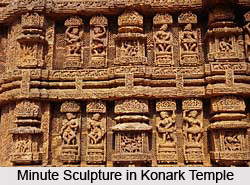 The upana (moulding) layer at the bottom of the platform contains friezes of elephants, marching soldiers, musicians, and images depicting the secular life of the people, including hunting scenes, a caravan of domesticated animals, people carrying supplies on their head or with the help of a bullock cart, travelers preparing a meal along the roadside, and festive processions. On other walls are found images depicting the daily life of the elite as well as the common people. For example, girls are shown wringing their wet hair, standing by a tree, looking from a window, playing with pets, putting on makeup while looking into a mirror, playing musical instruments such as the veena, chasing away a monkey who is trying to snatch items, a family taking leave of their elderly grandmother who seems dressed for a pilgrimage, a mother blessing her son, a teacher with students, a yogi during a standing asana, a warrior being greeted with a namaste, a mother with her child, an old woman with a walking stick and a bowl in her hands, comical characters, are among others.
The upana (moulding) layer at the bottom of the platform contains friezes of elephants, marching soldiers, musicians, and images depicting the secular life of the people, including hunting scenes, a caravan of domesticated animals, people carrying supplies on their head or with the help of a bullock cart, travelers preparing a meal along the roadside, and festive processions. On other walls are found images depicting the daily life of the elite as well as the common people. For example, girls are shown wringing their wet hair, standing by a tree, looking from a window, playing with pets, putting on makeup while looking into a mirror, playing musical instruments such as the veena, chasing away a monkey who is trying to snatch items, a family taking leave of their elderly grandmother who seems dressed for a pilgrimage, a mother blessing her son, a teacher with students, a yogi during a standing asana, a warrior being greeted with a namaste, a mother with her child, an old woman with a walking stick and a bowl in her hands, comical characters, are among others.
The Konark temple is known for its erotic sculptures of maithunas. These show couples in various stages of courtship and intimacy, and in some cases coital themes. Notorious in the colonial era for their uninhibited celebration of sexuality, these images are included with other aspects of human life as well as deities that are typically associated with tantra. This led some to propose that the erotic sculptures are linked to the vama marga (left hand tantra) tradition. However, this is not supported by local literary sources, and these images may be the same kama and mithuna scenes found integrated into the art of many Hindu temples. The erotic sculptures are found on the temple`s Shikhara, and these illustrate all the bandhas (mudra forms) described in the Kamasutra.
The massive structure of the temple, though now in ruins, sits in solitary splendor surrounded by the drifting sands. The huge wheels carved with intricate design of the rathas are the major attractions in the entire architecture of the place. The spikes of these huge and artistic wheels serve as sundials and with the help of the shadows formed by these wheels, one can be informed with the precise time of the day. The pyramidal roof of the temple adds in the glory of the architectural beauty. The roof is made from the sandstone and soars over 30 m in height. The sculptures carved on walls of the temple is accompanying a brilliant chronicle in stone, with thousands of images including deities, the surasundaris, which were known as heavenly damsels, and human musicians, lovers, dancers, etc. It also depicts different scenes that reveal around the courtly life.
Jagamohana of Konark Temple
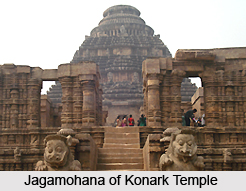 The jagamohana or porch, also called the assembly hall, at Konark follows the same architectural layout as the porches of other developed Orissan temples with a pancha-ratha plan. The brilliance of the artist who conceived the Sun Temple lay in juxtaposing the various constituent elements of sculpture and architecture in such a way that it represented a magnificent unified whole.
The jagamohana or porch, also called the assembly hall, at Konark follows the same architectural layout as the porches of other developed Orissan temples with a pancha-ratha plan. The brilliance of the artist who conceived the Sun Temple lay in juxtaposing the various constituent elements of sculpture and architecture in such a way that it represented a magnificent unified whole.
The jagamohana is the best preserved structure in the complex. Built on a low pishta or platform, the vertical portion of the porch wall (bada) has five horizontal divisions. In the conspicuously projected middle segment of temple on the front, north and south sides, arc provided doors and steps. The western raha provides a passage leading to the door of the sanctum.
The pishta consists of two mouldings with a honeycombed recess in between. The scrollwork, with animals, flowers and leaves woven within beaded borders on the lowest moulding, is capped at intervals by projected insets relieved with motifs of chaitya windows and animals.
As in all Orissa temples, the bada of this temple has five divisions -the lowest being the pabhaga, followed by lower jangha, bandhana, upper jangha and varanda. Each division is further divided into sets of lavishly carved mouldings set within beaded borders. The mouldings have at intervals ornate chaitya-window motifs, the khakhara-mundis or the miniature shrines with wagon-vaulted tops, carved on walls are elaborately composed. In the framed niches of these mundis are different compositions. One such is of a seated king, with a small sword in his hand, fronted by two figures, one with a manuscript and the other with a knapsack; a royal cavalier, shooting an arrow at two animals, in the company of a foot-soldier with a shield and sword.
Higher up on the bada, in some of the framed niches were freestanding sculptures, eight of which were dikpalas or the guardians of eight quarters: Indra (east), Agni (south-east), Yama (south), Nirriti (south-west), Varuna (west), Vayu (northwest), Kubera (north) and Isana (northwest). Most of these sculptures, which were of chlorite, were removed in the first half of the nineteenth century when there was a greedy hunt for carved chlorite pieces.
As one goes up the bada, pidha-mundis take the place of the khakhara-mundis. Many of these are empty, while others have life-size erotic figures in their niches. The veneer-stones of the front face of the rahas (middle segment of temple having greatest projection) have all but disappeared, except a small section at the base and the top of the north side.
Supported by iron beams, the architraves that project from the top of the doorframe were of chlorite with sculptured front faces. The eastern one, originally a monolith, is still at Konarak. The whereabouts of the other two are not known.
The front half of the eastern architrave is now in a shed erected within the complex. It is relieved with nine grahas (the sun, the moon and the planets) each within a tiered pavilion. The pacification of the planets (graha-shanti) is an essential element of Hindu astrology. Above the grahas is the carved frame of an oblong niche that once contained a seated image of Surya.
Of the doorframes, the one on the east is the best preserved, while the one on the north is partially preserved but still in position. Made of chlorite, these luxuriantly carved frames are similar in composition and execution. The eastern door-jamb is divided into eight facets, all on different planes, the innermost being the most receding and the outermost the most projected. The facets bear reliefs of foliated leaves, the double coil of a hooded naga couple, and a vertical succession of miniature pavilions with vajra-mundis (a variant of the khakhara-mundis) containing figures, amorous in nature.
The motifs on the facets, except the topmost, stop at the central part of the lintel that is divided into a succession of niches. In the lowest niche is an image of Lakshmi, the goddess of plenty, being bathed by a pair of elephants, each standing on a blooming lotus. Another niche depicts a bearded figure deep in meditation under a torana, the latter flanked by a makara, a mythical animal with the head of a crocodile and the body of a fish.
The stepped pyramid of the temple roof, above the vertical wall is called the gandi. It is in three gradually receding tiers (potalas), each tier separated from the other by a prominently recessed vertical wall (kanti). The kanti above the first and second tiers are relieved with khakhara-mundis, kanyas and pilasters. The vertical faces of the bottom and second tiers present minutely carved friezes depicting processions, in which elephants and the army - both infantry and cavalry - are the most conspicuous themes.
In the lowest recessed wall are 16 kanyas. Gracefully poised, they are variously engaged in adjusting their ornaments, wringing wet hair, or allowing a pet bird to drink the drops of water falling from their hair, and are mostly displayed in a variety of alluring and seductive postures.
These seductive figures, some strangely in sandals, have fascinated generations of tourists. Above the bottom tier, at either end, is a six-armed, four-headed, life-sized dancing figure of Bhairava with a ferocious expression, teeth bared in a snarl and a garland of skulls around his neck.
Juxtaposed against these grim-looking figures are the beauteous, life-sized images of female musicians. These boldly-carved, vivacious but dignified celestial choristers with their pliable plasticity and dynamic sweep create an unforgettable fantasy in stone. The instruments of this orchestra give us an indication of the musical instruments popular at the time: dholak, pakhavaj and a longish, cylindrical drum played upon with sticks, cymbals, karatala and the melodious veena.
Except for the youthful and serene veena player, fully absorbed in the rhythm of the music, all the other musicians are animated by the melodious music and seem to dance in harmony with the measures. The rhythmic actions of the limbs and the delicately tilted heads of some of these figures are unsurpassed in their beauty.
The mastaka or the crowning element of the temple above the gandi, consists of projected bands, a bell-shaped member (sri or ghanta), amla and khapuri, while the crowning kalasa is missing. The sri is divided into two parts by a central band, each part relieved with a row of long petals. It is supported by eight lions, of which four face the intermediate directions. Eight figures, seated on their haunches and with their hands resting on the round, support the amla on their backs. The interior of the porch, now inaccessible, is reported to have been plain but plastered.
Platform of Konark Temple
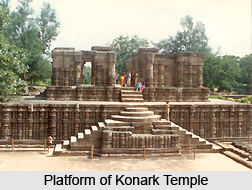 Konark Temple, Orissa stands on a magnificent platform which is over 4 metres high. Its facade richly carved bearing a well-moulded base. The next division corresponds to the lower jangha of the bada with upright slabs containing miniature representations of shrines with wagon-vaulted roofs (khakhara-mundis) in close succession. In the niches of these khakhara-mundis are mainly figures of beautiful women. One of these depicts a touching scene of leave-taking of an old mother, presumably on the eve of her departure on a pilgrimage. The mother, bent with age, tenderly blesses her son. The daughter-in-law reverentially wipes the dust off her feet, while the grandchild fondly clings to her.
Konark Temple, Orissa stands on a magnificent platform which is over 4 metres high. Its facade richly carved bearing a well-moulded base. The next division corresponds to the lower jangha of the bada with upright slabs containing miniature representations of shrines with wagon-vaulted roofs (khakhara-mundis) in close succession. In the niches of these khakhara-mundis are mainly figures of beautiful women. One of these depicts a touching scene of leave-taking of an old mother, presumably on the eve of her departure on a pilgrimage. The mother, bent with age, tenderly blesses her son. The daughter-in-law reverentially wipes the dust off her feet, while the grandchild fondly clings to her.
Upright slabs are boldly relieved with various motifs; erotic couples and voluptuous young women flaunting their beauty in various attractive postures. Other frequent motifs are of nagas or nagis, mythical beings who are depicted with a human bust, a multi-hooded canopy and the tail of a serpent coiled around a pillar and vyalas (composite animals).
The bandhana, the third division contains richly carved mouldings. Further up on the upper jangha of the platform are large pancha-ratha pilasters that are remarkable for their elaborate compositions. In one of the few surviving reliefs on the southern side is depicted a temple in which are enshrined images of Mahishasuramardini and Jagannatha and a linga. These reliefs indicate not only the extension of the royal homage to deities of the Vaishnava, Shakta and Shaiva cults, but also the existence of goodwill and a feeling of tolerance that apparently prevailed among the adherents of different sects.
Another interesting relief depicts a king, seated on an elephant, receiving the homage of a group of outlandish men clad in frilled petticoat-like lower garments. Evidently they have brought gifts for the king, one of which includes a giraffe. In some reliefs an important personage is shown seated on a low stool, delivering a discourse to a group of noblemen or princes` whose mounts - horses and elephants - are shown standing below the pavilion.
The top moulding of the platform contains a row of geese or four-petalled flowers alternating with diamond-shaped flowers, while below it are friezes of marching armies, a row of elephants, provision-carriers and an assemblage before a king with a beaded border below it.
Wheels of Konark Temple
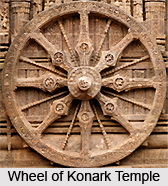 The wheels found on the chariot shaped Konark temple are exquisitely carved on the face of the jagamohana platform. These are so realistic that they even have an axle kept in position by a pin as it would be in an actual cart or chariot. The hub of the wheel is decorated with beaded rings and a row of lotus-petals; the latter in some wheels have dancers and musicians very rhythmically sculpted.
The wheels found on the chariot shaped Konark temple are exquisitely carved on the face of the jagamohana platform. These are so realistic that they even have an axle kept in position by a pin as it would be in an actual cart or chariot. The hub of the wheel is decorated with beaded rings and a row of lotus-petals; the latter in some wheels have dancers and musicians very rhythmically sculpted.
The thin spokes have a row of alternate beads and discs, while the broad spokes broaden further near the centre where they become roughly diamond-shaped. In the centre are richly carved medallions, containing numerous deities, erotic and amorous figures and kanyas in various poses. Similar medallions also occur on the face of the axle. The available ones portray a god in the company of a goddess (probably Shiva-Parvati), Krishna playing on a flute amidst cowherds; a king seated on an elephant facing a group of persons seeking mercy.
Festivals in Konark Sun Temple
The most popular and colourful festival of Konark, the Chandrabhaga festival an occasion for a splendid congregation of Indian pilgrims and enthusiasts from abroad, cascades on the seventh day of the new moon of Magha.












